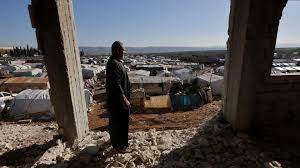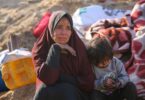Rasha Muhrez
When the earthquakes hit Turkey and Syria last year, claiming more than 50,000 lives, the question in the minds of many Syrians, myself included, was: “Could things get any worse?” Unfortunately, things did get worse.
The majority of Syrians affected by the earthquake have not been able to move on from the devastation. I see this in my own family. My 16-year-old cousin Naya has been unable to get over losing her sister – my 18-year-old cousin Maya – who was killed along with four other family members when our family home in Jableh collapsed. Her relentless grief is apparent in the steady stream of social media posts of all-black images and broken-heart emojis. On the earthquake anniversary, she wrote: “It’s been a year, Mimi, and you are far away from us. We miss your voice. We miss your laugh. We miss you so much. There is nothing in the world to compensate for your absence from us.”
We often ask ourselves if our loved ones could have been saved, if only the rescue teams had arrived on time, if only the world had not turned its back on Syrians, if only the war had never happened. My cousins’ bodies were still warm when they were taken out of the rubble. The earthquake ravaged an already suffering population. Syrians lost family members, homes, livelihoods, the little sense of stability they may have had amid the continuing war. Over the past year, the number of Syrians requiring humanitarian assistance has surged from 15.3 million to 16.7 million, the highest since the start of hostilities about 13 years ago. And yet, the greater need has not been met with adequate funding; to the contrary, contributions have dwindled.
As humanitarian workers, we are told to prioritise – that is to make impossible choices. If the situation does not change, I fear there will be catastrophic consequences for Syrian children. Since the earthquake, the country has faced a number of challenges that have only exacerbated the situation, including renewed conflict, a severe economic crisis, and climate change-related disasters.
The most significant escalation in conflict in the past five years hit northern Syria in October, killing and injuring dozens and displacing at least 120,000 in opposition-held northwest Syria. Airstrikes in southern and central Syria in January have posed additional threats. The ongoing economic crisis, worsened by sanctions, has made life unbearable for ordinary Syrians. In 2023, the Syrian currency lost nearly 60 percent of its value to the dollar. This was accompanied by skyrocketing inflation which transformed basic necessities into luxuries.
A staggering 90 percent of households struggled to cover essential needs, leaving families to make tough decisions for their children. “We are barely surviving… everything has become expensive,” said Zaina*, a mother of six, living in an informal camp in Raqqa supported by Save the Children.
“I light a fire with wood, turning it into cinders [and bring it inside the tent to keep my children warm]. You know, it smokes a lot and it impacts their health,” she told Save the Children staff. “If you go to the doctor, he says it is because of the smoke. Either smoke or cold. We do not know what to do.” Too many families, like Zaina’s, face the agonising reality – deciding between the health of their children and heating their homes. It’s an impossible choice amid a harsh winter.
The freezing cold came after a scorching hot summer marked by erratic rainfall, which triggered devastating wildfires across the country in July, affecting 73 villages and around 50,000 people. Many children, like my cousin Naya, are reeling from the double blow of conflict and earthquakes. Returning to school after the loss of her sister, she has few avenues for support.
There’s almost no mental health support available for young people, despite almost 70 percent of children struggling with sadness, according to a survey by Save the Children. Around one-third of Syrian households have children showing signs of mental distress, the UN reported. Over half of healthcare workers, including qualified mental health professionals, have left the country over the past decade.
“I still feel the ground shaking,” one eight-year-old boy in northern Syria told our staff, “It’s not just the earthquake that scares me – dozens of bombs fell on our camp.” The boy’s father died in a bombing before the earthquake. His mother lives off aid, with barely enough money to buy bread. She says he has become more and more withdrawn, living in constant fear for his life.
Before the earthquake, the education system in Syria was already struggling. According to the UN, more than 7,000 schools had been damaged or destroyed. Some two million children were not attending school and 1.6 million were at risk of dropping out. The earthquake made the situation even worse, especially in northwest Syria, where 54 percent of schools were affected. Many areas hit by the earthquake had been focal points of conflict in the last five years. The earthquake devastated communities already struggling to cope. It impacted people already at breaking point – mentally, physically and financially.
Just as needs have gone up, aid has gone down. The UN humanitarian response plan was only 37.8 percent funded in 2023. Late last year, media reports indicated that the World Food Programme (WFP) will stop much of its main food assistance programme in the country this year due to a lack of funding. In parallel, international awareness of the crisis in Syria is also fading, prompting many to fear that the world is forgetting the Syrian people. Following the tragic deaths in my family, I addressed the UN Security Council last year urging the international community to use the earthquakes as a moment to reevaluate its approach to Syria.
As both a Syrian and a humanitarian, I warned that the earthquake could push the country to the brink, leaving the next generation heavily dependent on aid.
I asked whether simply keeping children alive, without addressing the root cause of the humanitarian crisis would be enough. We urgently need to do things differently, but change is yet to come.
The path forward remains clear – we need to restore basic services in Syria. Beyond rehabilitating damaged or dilapidated infrastructure, we need to create safe spaces and schools for children, train teachers and pay them properly. We need investment in sustainable projects focused on helping parents to access jobs that pay a decent wage, supporting farming so people are less reliant on food assistance, and reinforcing health systems so children can grow up healthy. We have to ensure that children and their families can access proper mental health support so they can cope with everything they have been forced to endure.
Right now, there’s nowhere near enough funding or support to achieve any of this. Our work as humanitarians has never been harder. We need not only financial assistance, but also the space and security to operate and create change on the ground. We simply cannot keep doing the same things, with fewer resources and expect to see better outcomes for children. The world is of course a more fragile place today than it was a year ago, and Syria is among a growing number of countries grappling with multiple crises.
But the international community has a responsibility to ensure that all children, wherever they are, can grow up in safety, dignity and hope. Only through collective action, sustained support, and a commitment to meaningful change can we hope to build a better future for Syria. As we remember the earthquakes that shook our world, let us not forget the ongoing struggle of the Syrian people.







